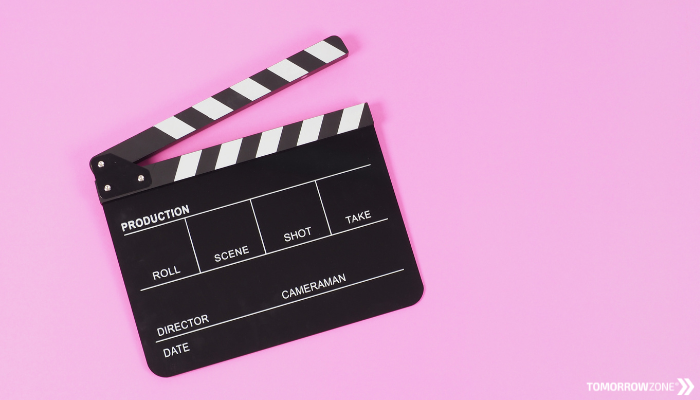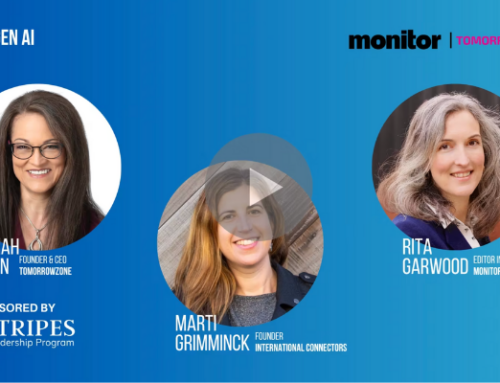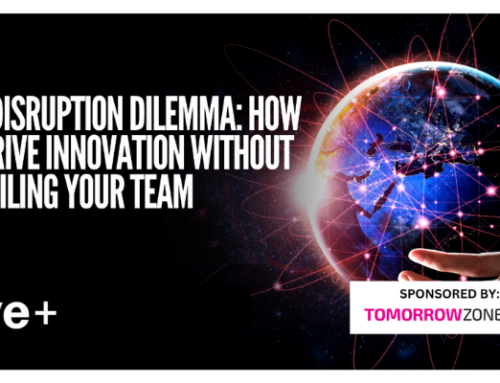
This article was originally published by MonitorDaily in September 2023.
Reprinted with permission from the author.
Comedy writing might seem like it has nothing to do with equipment finance, but sometimes it takes looking outside of your industry to learn how to innovate. Deb Reuben of TomorrowZone spoke with Bill Stainton, an Emmy-award winning television writer and producer, about how collecting outside knowledge and perspective can be the catalyst for innovation.
Whether it’s equipment finance or comedy writing, diversity of thought and diversity of input help us to connect the dots in new and interesting ways. Unconventional ideas can lead to breakthrough thinking and tangible value creation. Now, more than ever, leaders need to boost their teams’ creativity and innovation potential. But how do you do it?
To delve into this subject, I sat down with 29-time Emmy Award winner (and Hall of Fame speaker) and creative innovation expert Bill Stainton. The following is our interview condensed and rephrased for conciseness.
Deborah Reuben: What led you to what you do today?
Bill Stainton: Born in Lancaster, PA, I grew up near our Amish neighbor’s dairy farm and learned to milk cows at an early age. I studied broadcast and comparative international communications, initially planning to pursue a Ph.D. By accident, I landed a job in television. Surprisingly, it came down to a typing test against another candidate. Since I had taken a typing course, I secured the position.
As a glorified secretary, my first television job was answering viewer mail. Most of my career was spent producing various television shows. I was the producer, writer and performer for the country’s longest-running, highest-rated and most award-winning regional comedy television show [Almost Live!]. Bill Nye worked on my show before becoming ‘The Science Guy’ (a character our show invented). Although based in Seattle, we were also on Comedy Central for two and a half years.
Producing comedy revealed that waiting for inspiration and relying on lightning bolt moments would not sustain a career in creativity. You must intentionally collect dots and connect them uniquely. Unexpected experiences, conversations and knowledge can become valuable puzzle pieces later.
I learned an awful lot about leading a creative team, a specialized branch of leadership. Every leader is leading creative people, whether they know it or not; whether their people know it or not. Every leader is leading an innovative team. Do you take advantage of it or not?
After 15 successful years, when the show was eventually canceled, I faced career disruption. But disruptions happen; it’s during these times that innovation becomes crucial.
Realizing my comedy writing and producing skills were not limited to television, I focused on using my speaking experience (performing and doing the audience warm-up for years) and expertise in leading creative teams. I gave keynotes on innovation, creativity and breakthrough thinking. Most of my post-television career was focused on being a keynote speaker. It’s been a rewarding journey, and I am honored to be in the Speaker Hall of Fame [of the National Speakers Association].
While keynotes are entertaining and can have an impact on individuals, they don’t often lead to lasting change. People enjoy the hour-long presentation but then move on with their lives. Striving to go deeper, I am now helping leaders make a meaningful impact within their teams and their worlds.
The truth is, every leader is leading a creative team, whether they recognize it or not. Innovation is not exclusive; it’s accessible to all of us. Unfortunately, many people fail to take advantage of it because they perceive it as reserved for a select few. I want to change that mindset and empower everyone to embrace innovation.
Reuben: How do you define creativity and innovation?
Stainton: In colloquial terms, we often use the words “creativity” and “innovation” interchangeably, but they are not synonymous. It’s not just a matter of semantics. Here’s how I define it: Creativity is about generating ideas, connecting dots and coming up with a multitude of ideas. In the field of creativity, the quantity of ideas contributes to the quality.
I once authored an article, “Creativity is worthless, but innovation is priceless.” In my television language, I refer to the process as “lights, camera, action.” “Lights” represent the ideas, the light bulbs that go off in our minds. Generating ideas is the creative part, which is enjoyable and exciting. This is what people typically associate with innovation. However, there’s more to it.
Then we move on to the “camera” stage. The camera focuses, and we need to determine which idea or ideas to focus on. We can’t pursue all the ideas, so we must identify the few we believe are worth investment. This selection process is critical for innovation. Innovation is turning creativity into money; innovation is taking an idea and turning it into something tangible of value. [Emphasis added] Finally, we have “action.” This is where innovation truly takes place. It’s about transforming the chosen idea into something tangible and valuable. Innovation turns creativity into something practical and impactful. The outcome doesn’t have to be monetary. It can be a time-saving solution or any novel way of delivering value to others. Whether inventing revolutionary products like the iPhone or Tesla, or simply improving a small aspect of a process, innovation creates tangible results that make a difference.
Reuben: How can leaders boost creativity in their teams?
Stainton: You can apply this technique immediately. Innovation is about connecting dots. To do that, you need to collect dots. Unfortunately, most of us collect the same dots repeatedly. Sticking to familiar articles, industry journals and conventions limits our perspective.
Break free of this pattern by collecting diverse dots. Search for, read or listen to a topic unrelated to your daily work. Then ask yourself how you can apply it to your own world.
It’s even more powerful when you identify a specific challenge you’re facing in your professional or personal life before diving into unrelated content. Whether a parenting issue or a supply chain problem, read an article on macramé or any other topic that piques your curiosity but seems unrelated. Then explore how you can connect the ideas from that content to your situation.
It’s crucial to frame your exploration with the question of application to your circumstances. Posing better questions to your brain activates its problem-solving abilities. When you provide your brain with more thoughtful inquiries, you’ll receive better insights and solutions.
Instead of asking, “Can this apply to my world?” which may prompt your brain to dismiss it, ask, “How can I apply this?” This engages your brain in making connections. Grab a notepad and any writing tool and challenge yourself to produce at least three answers. This is how you train your brain to seek connections and ideas.
Most of us collect the same dots repeatedly. By intentionally seeking out different dots and combining them with the familiar ones, you create fresh ideas and connections. Look outside your usual field and intentionally search for those different dots.
As a comedy writer and television producer, I often enter fields where I’m not an expert. This allows me to ask unconventional questions and make suggestions that others may consider silly. Within those seemingly foolish ideas, there can be hidden gems leading to breakthroughs. Unusable ideas can spark a chain of thought that leads to success.
We often experience the “idea leading to the idea” in comedy writers’ rooms. Someone brings up an idea we can’t put on television. But wait, there may be a nugget in there we can use. Boom, suddenly [you’ve got] Emmy No. 27 because someone said something seemingly stupid, unworkable, outlandish or expensive, and we found the nugget within it.
Sometimes unexpected ideas hold the seeds of greatness. The key is being open to unconventional thinking and recognizing value in ideas that initially appear unworkable.
Reuben: As a creative writer, what do you think about the disruptive possibilities of ChatGPT?
Stainton: ChatGPT is like an imperfect, unpaid research intern. You ask it to find information and it generates results that may offer new perspectives. Don’t blindly trust everything it says. I once asked it to find articles, and it provided me with non-existent sources.
Generative AI is an evolving field; the technology will continue to improve. The implications for our society remain uncertain, but we cannot ignore the fact that AI is here to stay.
Every tool or technology can be used for good or evil; it depends on how we use it. ChatGPT is an excellent collaborator and brainstorming companion. I appreciate its capabilities and look forward to its future enhancements. It is an experiment, and we should embrace its potential while being cautious and discerning.
Reuben: Can you share about your quest for continual learning?
Stainton: I find my greatest happiness in learning new things. Whether mastering a new piano piece, exploring a musical instrument, picking up a new language or even flying airplanes.
Speaking of flying, I’ve been a pilot since 1984 when I obtained my pilot’s license. I had an inspiring flight instructor who showed me her pilot’s license, signed by Orville Wright himself. Growing up with my dad’s love for airplanes, I always had a desire to get my own license. However, like many others, I faced common obstacles: It seemed too big, too expensive, too time-consuming and too difficult.
Once I realized taking the first step was within reach. I looked up flight schools in the Yellow Pages (yes, this was a while ago) and scheduled my first lesson. Getting a pilot license seems big, but I can take the first lesson. I focused on the process rather than getting overwhelmed by the goal.
Learning to land an airplane was initially challenging, and I made mistakes. My instructor had to intervene in some nerve-wracking moments, and I worried about damaging the plane. But that’s the nature of starting something new. We all start as beginners. Remember when you were learning to walk? Falling didn’t discourage you from trying again. Yet, as adults, we tend to give up easily when faced with new challenges.
Reuben: What can leaders do today to shape a more awesome tomorrow?
Stainton: I asked ChatGPT. It gave a standard answer. It went on and on about how leaders should invest in learning and personal development, continually improving their skills and understanding within their industry and organization through industry conferences, networking and mentoring.
While I like the overall direction of continuous learning, what I don’t like is just saying collect more navy blue dots in your industry. That just leads to an “improved” tomorrow because you are just looking at the same type of dots. If your competitor has a navy blue dot, you pursue making a bigger navy blue dot [and] they make an even bigger one. It becomes this arms race of continual improvement.
No! The breakthroughs come with those yellow dots or the plaid dots or other outside dots.
The real way to make an awesome tomorrow, the kind of tomorrow that you can’t even imagine now: Collect dots that you aren’t currently collecting. Travel to a different country. Learn a new language. Read and listen to things outside of your industry. Yes, keep up on your industry, but also follow your curiosity outside the industry. Ask, “How can I apply this? How can I connect the dots?”
When you get your brain into the practice of asking these questions, you will be amazed. In short order, you’ll turn into an innovation machine. That’s how you can create an awesome tomorrow.





